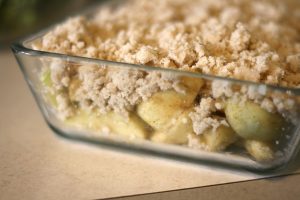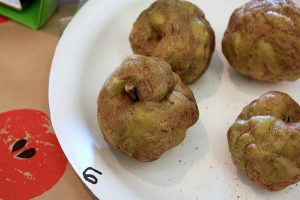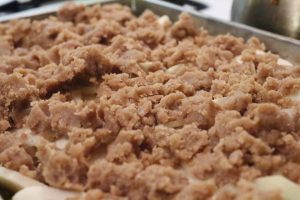3 Apple: Apple Crisp
An apple a day keeps the doctor away. Caveat: the choice of your apple is more important than the frequency of its consumption.

News Flash: Healthier apples – dropped from 2nd to 4th place on the Dirty Dozens list, now only the 4th most pesticide contaminated produce. Sorry for disappoint and kill your love of the fruit, but a 2-rank drop does not guarantee safety. Washing, even with a nice concoction of baking soda or bleach, will not yield a pesticide-free fruit. The tale of pesticide-laden apples can begin with the lost of traditional orchards.
Take U.K. as an example: over 60% of apple orchards in the U.K. have been lost, and the rest of the world’s orchards are following a similar trend. And yet, consumption has not changed – in fact it has increased (check out the introduction of sliced apples to children!). To meet demands, the remaining orchard and their farms spray pesticides to the chosen few varieties you see in all grocery stores. The result of the above trend is agricultural pollution, wildlife habitat loss and health issues.

Hopefully, the above wonderful analysis of today’s apple industry does not turn you off from eating apples…if so, the apple crisp recipe below will be wasted. Know how to pick the right apples to bake, serve and eat a sustainable and healthy dessert!
Play Your Part:
- Choose the weird apples – try the heirloom varieties in your region. Check out the US varieties by region.
- Buy locally, and organic – try apple-picking in the fall
- Educate and teach about the dangers of pesticide use. Check out the official 2017 Dirty Dozen list by Environmental Working Group.
I never liked apples, and I still don’t. But coming to the US for college, I tried my first ever apple crisp – and till now, this is the only way I will eat an apple. Learn how to choose the right apples, and then get baking using a tested recipe, from a friend who introduced me to the wonders of baked desserts!

Apple Crisp (adapted from Kitchn’s 4-Step Guide to Making Crisps)
Yield: Serves 4-8
Ingredients:
For the filling
- 1/2 cup granulated sugar
- 2 tbsp cornstarch
- 6 cups sliced fresh apple (see Play Your Part to select apple)
- 1 tbsp freshly squeezed lemon juice
For the topping
- 1 1/2 cup old-fashioned rolled oats
- 1 cup all-purpose flour
- 1/2 cup packed light brown sugar
- 1/2 tsp salt
- 1/2 tbsp (6 ounces) unsalted butter, melted and cooled, plus more for buttering baking dish
- 1 tsp vanilla extract (optional)
Directions:
- Heat the oven and prepare the baking dish. Arrange a rack in the middle of the oven and heat to 350°F. Coat a 9×9-inch or 11×7-inch glass baking dish with butter; set aside.
- Make the fruit filling. Whisk together the sugar and cornstarch in a medium mixing bowl until lump-free. Add the fruit and lemon juice and toss gently to coat. Transfer to the baking dish.
- Make the crisp topping. Combine the oats, flour, sugar, and salt in a large bowl and stir until combined. Drizzle the butter and vanilla over the oat mixture and stir to combine. Set aside or store in the freezer in a zip-top freezer bag for later use.
- Top the crisp. Scatter the crisp topping evenly over the fruit mixture, leaving large clumps intact.
- Bake the crisp. Bake until the fruit juices are bubbling around the edges of the baking dish and the topping is golden and firm to the touch, 30 to 35 minutes.
- Cool the crisp. Let the crisp cool on a wire rack for at least 15 minutes before serving. If transporting to a picnic or party, let the crisp cool completely to give the fruit filling time to set. Crisps will keep, covered and refrigerated, for up to 1 week. Serve cold, room temperature, or re-warmed in a low oven for 20 minutes.
Recipe Notes:
- Crisp topping can be made and frozen up to 3 months in advance.
- Cover and refrigerate leftover crisp for up to 3 days. Enjoy cold for breakfast or gently rewarm in a low oven for 20 minutes before serving.
